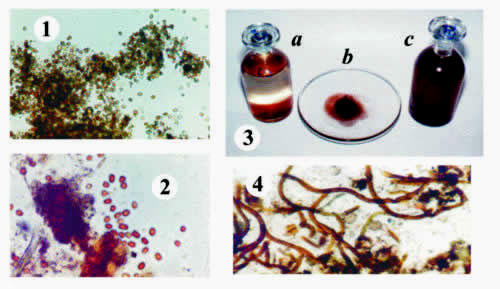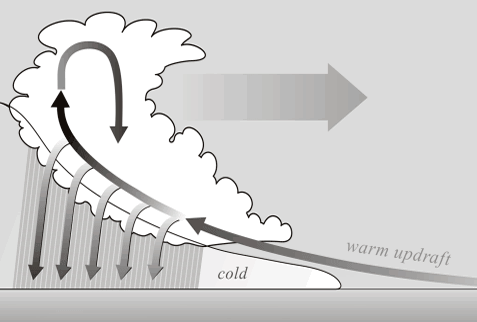|

by Ian Williams Goddard
03/22/06
from
IanGoddard Website
Imagine stepping out into a rain shower
only to find it was raining blood! That's what it looked like to
residents of Kerala, India in 2001 when red rains fell in scattered
areas over three months. Some rains were even yellow, green, or
black. [1] Experts scrambling for answers first suggested that
fallout from a hypothetical meteor explosion may have colored the
rain. More recently, news reports suggest such a meteor burst may
have colored the rain with extraterrestrial cells. [2-4]
Research
Overlooked by the Media
Overlooked by recent news reports is the study commissioned by the
Government of India in 2001, conducted by Sampath et al. They found
that the rainwater was colored by spores from a locally prolific
aerial algae of the Trentepohlia genus. [5] Accounting for all the
observed colors, Trentepohlia spores can be red or green, and
degrees of their dilution can make rainwater appear yellow or black.
Sampath et al. estimated that at least
one ton of the spores fell in the rain [6] and they cited the
still-unanswered question: How did so many local spores contaminate
the rain, and why in only scattered areas during the 2001 monsoon?
[5]

Frames (1) and (2)
show the microscopic spores that colored the Keralan rains;
(3) rain samples with
(a) spores settled to the bottom, (b) rainwater evaporated, and (c)
spores suspended in the rainwater;
(4) Trentepohlia
algae grown from the spores. [5]
Regarding the extraterrestrial-microbe
hypothesis, Sampath et al found no meteor debris in the colored
rainwater. Moreover, the extraterrestrial hypothesis rests on the
assumption that a loud thunder and flash of light during a storm was
an exploding meteor. However, a better causal explanation for a
thunderous sound and flash of light during a storm is thunder.
Additionally, just the fact that the
colored rains fell sporadically over three months refutes a
meteor-burst event as the cause. Finally, given that the spores grew
in culture into a known species of algae, the extraterrestrial
hypothesis seems to be without factual grounding.
An Answer to
the Mystery?
But the question remains: how did so many local spores contaminate
rains in scattered areas? While rains colored red by desert sands or
yellow by pollen have been reported and analyzed around the world
over several centuries, [7-12] the Keralan rains may be the only
cases of rain colored exclusively by spores.
So what might cause such a proliferation
of spores? Unique rain patterns in Kerala during 2001 may have
played a role. Given a period of above-average rainfall weeks before
and then below-average rainfall just prior to and during the colored
rains, [13] there may have been an algae bloom and then a build-up
of spores.
So a simple explanation would be that the winds of a storm lofted up
spores that accumulated during the dry spell and then its rains
washed them down. However, most airborne spores of the given
ultra-light size (3 to 5 micrometers [5]) would be swept aside by
falling raindrops rather than being absorbed into them. [14]
Yet raindrops in Kerala were so
thoroughly contaminated by spores that in some cases they were as
red as blood. The rain was also reported to have been clear for some
time prior to the sudden onset of colored rain. [5]
Those facts do not favor a simple washout but suggest instead that
spores had already contaminated some portion of the rain before it
fell from the clouds, which in turn suggests the transport of local
spores into local clouds followed by their local rainout. Such a
local model differs from the atmospheric dynamics underlying typical
colored rains where a potpourri of aerosols are transported from
remote locations via upper-atmospheric winds. So by precisely what
mechanism could such local aerosol input and output occur?
Storm-Circulation
Model
The anatomy of a self-propagating storm
provides an attractive causal model. [15] Such anatomy is depicted
in the following illustration showing by way of arrows the possible
paths that might be taken by accumulated spores lofted up by the
warm updraft flowing from ground-level forward of a storm up and
into the storm.

Anatomy of a
self-propagating storm.
Accumulated spores
forward of a storm cloud are lofted up and carried into the cloud
via its warm updraft.
Spores within the
cloud may follow one of the many possible paths (depicted by arrows)
before they rainout.
It is useful to think of such a storm as
a machine that inputs airborne spores, processes them into rain
droplets by absorption or nucleation, and then outputs spore-colored
rain. Given the variable proclivities of machines or of the input
thereto, it could happen on rare occasion that the output is
atypically concentrated.
In this case such atypical output may
have been due to an atypical input of built up local spores.
Furthermore, given the likelihood of scattered showers due to
below-average rainfall within the timeframe of the colored rains,
such concentrated spore-rain output might be expected to occur only
over scattered areas as reported.
Therefore, the storm-circulation model provides a possible answer
the question raised by Sampath et al: How did so many local spores
contaminate the rain, and why in only scattered areas during the
2001 monsoon? An unusual pre-monsoon wet period spurred an algae
bloom; then spores accumulated during a dry spell; then the spores
were lofted up and drawn into scattered storms wherein they were
concentrated and then rained out onto scattered areas. Of course the
final answer can only come from further research of the Keralan
environment.
For detailed analyses of a range of possible causal mechanisms of
the Keralan red rains, see my full paper: Goddard, I.W. (2006). The
Colored Rains of Kerala: An Exploration of Possible Causal
Mechanisms. Noesis, 180 (March): 10-18.
References
-
[1] Mathew, R. (2001). Multicolour
rain. The Hindu, Jul 29.
-
[2] Editors. (2006). Skepticism
greets claim of possible alien microbes. World Science, Jan 5.
-
[3] Gentleman, A., & McKie, R.
(2006). Red rain could prove that aliens have landed. The
Observer, Mar 5.
-
[4] Muir, H. (2006). When aliens
rained over India. New Scientist, Mar 2.
-
[5] Sampath, S., Abraham, T.K., Sasi
Kumar, V., & Mohanan, C.N. (2001). Coloured Rain: A Report on
the Phenomenon. CESS-PR-114-2001, Center for Earth Science
Studies and Tropical Botanic Garden and Research Institute.
Sampath et al abstract only.
And reported in: Indian National Report for the International
Union of Geodesy and Geophysics 23rd General Assembly, July
2003. Indian National Science Academy. See pages 31-2.
-
[6] Kumar, V.S., Sampath, S.,
Mohanan, C.N., & Abraham, T. K. (2002). Colored rain falls in
Kerala, India. Eos, Transactions of the American Geophysical
Union, 83(31), 335.
-
[7] Thompson, D.P. (1849).
Introduction to Meteorology. London: William Blackwood and Sons,
150-66.
-
[8] The editors. (1851). On the
Infusoria and other Microscopic forms in Dust-showers and
Blood-rain. The American Journal of Science and Arts, Second
Series, 6, May, 372-83.
-
[9] McAtee, Waldo I. (1917). Showers
of Organic Matter. Monthly Weather Review, 45(5), May, 217-224.
-
[10] The editors. (1968). Red Rain.
Nature, 219, 112.
-
[11] Associated Press. (2006). Storm
drops dark brown snow on Colo. Feb 17.
-
[12] MosNews. (2006) Creamy pink
snow covers Russian region. Mar 13.
-
[13] Kumar, R.K. & Revadekar, J.V.
(2001). Weekly evolution of the 2001 Indian summer monsoon
season. Indian Institute of Tropical Meteorology.
-
[14] McDonald, J.E. (1962).
Collection and washout of airborne pollens by raindrops.
Science, New Series, 135(3502), 435-6.
-
[15] Scorer, R.S. (1978).
Environmental Aerodynamics. New York: John Wiley & Sons, 430-3.
And in: Scorer, R.S. (1997). Dynamics of Meteorology and
Climate. New York: John Wiley & Sons, 519-21.
|


